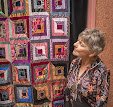

At the 2008 BQSG Seminar I showed a large cotton textile, dated 1906, which I had borrowed from the Design and Textile Archive of Stead McAlpin in Carlisle. The main point of interest was that this large item (108" X108"),printed with a centre design surrounded by borders, was described in the archive records as ‘a quilt’. As far as I can discover so far, there are no surviving examples of either quilts or coverlets of this size and style yet the records show that large numbers of these textiles were made and dispatched during the late 19th and early 20th centuries. So the questions arise: what were they for, how were they used and, even more curiously, where did they go?
After a follow-up visit to the archive, I can at least clarify one aspect of the textile which was puzzling: it is very stiff, almost canvas-like, so it was hard to see how it could ever be quilted in the conventional sense, either by hand or machine, even assuming that was its intended function. I now know that the textile as seen by us is in an unfinished state, i.e. straight from the printing process. It would then have been subjected to a further long processes of treatment to both fix the printing and to soften the fabric. In other words, when it left the mill it would have been in a suitable condition for use as a household textile in whatever capacity. It has been suggested that the reason it remained at the mill, rather than being dispatched, may have been some fault in the printing.
After a follow-up visit to the archive, I can at least clarify one aspect of the textile which was puzzling: it is very stiff, almost canvas-like, so it was hard to see how it could ever be quilted in the conventional sense, either by hand or machine, even assuming that was its intended function. I now know that the textile as seen by us is in an unfinished state, i.e. straight from the printing process. It would then have been subjected to a further long processes of treatment to both fix the printing and to soften the fabric. In other words, when it left the mill it would have been in a suitable condition for use as a household textile in whatever capacity. It has been suggested that the reason it remained at the mill, rather than being dispatched, may have been some fault in the printing.
This, unfortunately, doesn’t take us much further in determining the ultimate fate of these textiles, the one I showed being but one of many. One suggestion is that they may have been made for export and, America being a very likely destination for such goods, I'm asking mmbers of the American Quilt History List (QHL) if anyone can cast further light on the subject.
The photos show the top half of the textile and the centre motif respectively.

